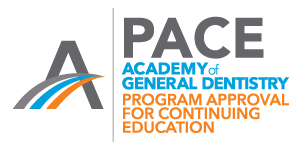- Treatment options for the edentulous patient
- Anatomical factors to consider when treatment planning a full-arch restoration
- The advantages of implant-supported full-arch restorations
- Treatment protocol for combination denture and implant cases
- Intraoral and radiographic examination of the edentulous patient
- Extraction with immediate implant placement for patients with terminal dentition
- Basic surgical and bone grafting techniques for full-arch implant cases
- Immediate provisionalization with a fixed temporary denture
- Restorative workflow for the monolithic zirconia full-arch implant prosthesis
Removable and Fixed Solutions for the Edentulous Patient
Course Objectives
1 CE Credit
Modern dentistry affords the clinician a range of options for successful treatment of the fully edentulous patient. In this multimedia presentation, Dr. Paresh Patel demonstrates how, by carefully considering the oral health and devise a treatment plan that effectively restores form and function.
Topics include:
Summary
Practitioners have several options for treating the edentulous arch, providing a great deal of flexibility in addressing the unique needs of each case. By comprehensively assessing the patient’s chief complaint, bone volume and anatomical landmarks, as well as the fit, stability and comfort of any existing oral appliances, clinicians can confidently determine whether a traditional complete denture or an implant-supported prosthesis is indicated.
Recognition & Approval

Glidewell Education Center
Nationally Approved PACE Provider for FAGD/MAGD credit
Approval does not imply acceptance by any regulatory authority, or AGD endorsement. 3/1/2024 to 2/29/2028.
Provider ID# 216789
References
- Zembic A, Wismeijer D. Patient-reported outcomes of maxillary implant-supported overdentures compared with conventional dentures. Clin Oral Implants Res. 2014 Apr;25(4):441-50.
- Turkyilmaz I, Company AM, McGlumphy EA. Should edentulous patients be constrained to removable complete dentures? The use of dental implants to improve the quality of life for edentulous patients. Gerodontology. 2010 Mar;27(1):3-10
- Brennan M, Houston F, O'Sullivan M, O'Connell B. Patient satisfaction and oral health-related quality of life outcomes of implant overdentures and fixed complete dentures. Int J Oral Maxillofac Implants. 2010 Jul-Aug;25(4):791-800.
- Preciado A, Del Río J, Lynch CD, Castillo-Oyagüe R. Impact of various screwed implant prostheses on oral health-related quality of life as measured with the QoLIP-10 and OHIP-14 scales: a cross-sectional study. J Dent. 2013 Dec;41(12):1196-207.
- Misch CE. Contemporary implant dentistry. 3rd ed. St. Louis: Mosby; 2007. p. 367.
- Colomina LE. Immediate loading of implant-fixed mandibular prostheses: a prospective 18-month follow-up clinical study–preliminary report. Implant Dent. 2001;10(1):23-9
- Najafi H, Siadat H, Akbari S, Rokn A. Effects of immediate and delayed loading on the outcomes of all-on-4 treatment: a prospective study. J Dent (Tehran). 2016 Nov;13(6):415-22.
-
 Online CE CourseNext-Level Chairside Esthetics: Customizing Restorations with Stain, Glaze, and Finishing TechniquesIn this course, Dr. Justin Chi demonstrates how to elevate chairside restorations using advanced staining, glazing, and finishing techniques for monolithic restorations.
Online CE CourseNext-Level Chairside Esthetics: Customizing Restorations with Stain, Glaze, and Finishing TechniquesIn this course, Dr. Justin Chi demonstrates how to elevate chairside restorations using advanced staining, glazing, and finishing techniques for monolithic restorations. -
 Online CE CourseEsthetic Veneer Preparations: From No Prep to Full PrepIn this course, Dr. Danielle Brown provides a practical overview of veneer preparation techniques from no-prep, minimal-prep and traditional-prep veneers with step-by-step protocols.
Online CE CourseEsthetic Veneer Preparations: From No Prep to Full PrepIn this course, Dr. Danielle Brown provides a practical overview of veneer preparation techniques from no-prep, minimal-prep and traditional-prep veneers with step-by-step protocols. -
 Online CE CourseBonding and Temporizing Protocols: Tips for VeneersIn this course Dr. Danielle Brown offers practical guidance on veneer temporization and bonding techniques to improve patient comfort and clinical outcomes.
Online CE CourseBonding and Temporizing Protocols: Tips for VeneersIn this course Dr. Danielle Brown offers practical guidance on veneer temporization and bonding techniques to improve patient comfort and clinical outcomes.




